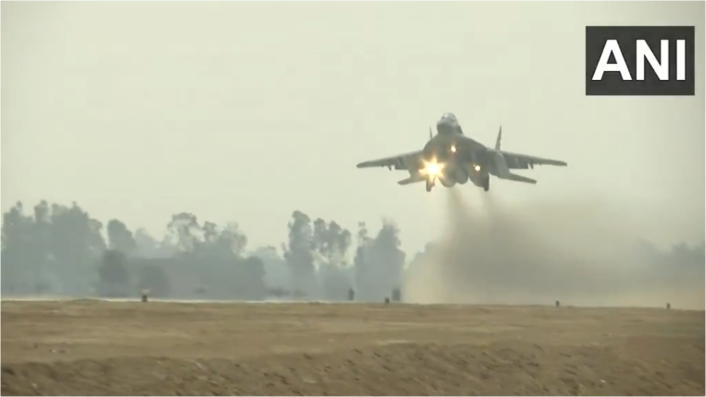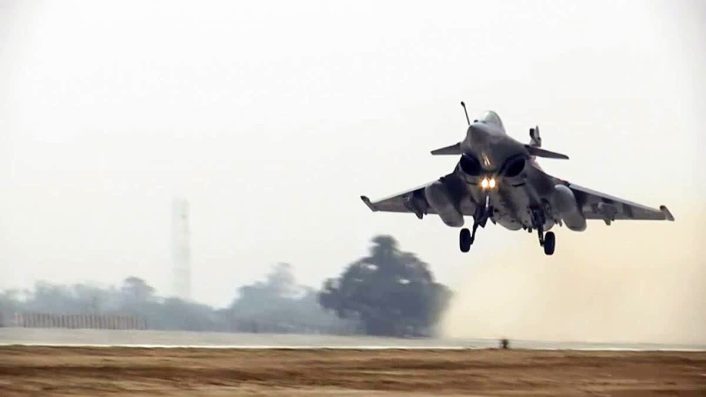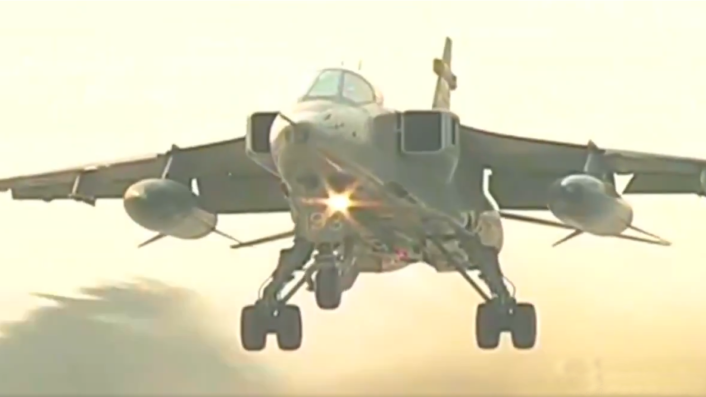Nearly all IAF aircraft types were used during the highway operation, while Pakistan is similarly conducting a series of drills in a show of force.
On May 2, 2025, the Indian Air Force (IAF) conducted touch-and-go operations on a 3.5-kilometer stretch of the Ganga Expressway in Uttar Pradesh’s Shahjahanpur district. The exercise featured various frontline aircraft, including Rafale, Sukhoi Su-30MKI, Jaguar, and Mirage 2000 jets, demonstrating the IAF’s operational readiness.
These drills occurred amid heightened tensions following a tragic incident on April 22, when 26 civilians, primarily tourists, were killed in an attack in Kashmir’s Baisaran Valley near Pahalgam. The Resistance Front, an offshoot of the Pakistan-based Lashkar-e-Taiba, initially claimed responsibility for the attack but later retracted the claim.
India has accused Pakistan of supporting cross-border terrorism, leading to diplomatic measures such as suspending visas and trade relations. Pakistan has denied involvement and called for a neutral investigation.
Both nations have engaged in military posturing, including Pakistan’s test-firing of a ballistic missile on May 3, signaling operational readiness. International actors, including the United States, have urged both sides to exercise restraint and engage in dialogue to prevent further escalation.

Dealing with the highway operations, both the Indian and Pakistani air forces have routinely conducted exercises during peacetime, including use of road-based infrastructure. While the IAF previously operated from the ELTs (Emergency Landing Tracks) in northern India, according to India Today, this is the first time night operations have been conducted.
This concept of operations has been described as the IAF’s own version of the U.S. Air Force’s ACE (Agile Combat Employment), but it has not been officially identified as such so far. Constructed with reinforced concrete and equipped with mobile infrastructure, Indian ELTs have also seen movement of mobile radars, air traffic control units, refueling, and weapon-loading equipment.
Shahjahanpur: The Indian Air Force (IAF) is carrying out a flypast on the Ganga Expressway in Uttar Pradesh. The Air Force is conducting take-off and landing exercises here.
IAF SU 30 also took part in this exercise pic.twitter.com/aRyA74GPuO
— War & Gore (@Goreunit) May 2, 2025
Images and visuals by Asian News International (ANI) showed a C-130J Super Hercules, An-32, Mirage 2000, Jaguar, Su-30MKI and MiG-29 either flying overhead or landing in both daytime and nighttime operations. A Rafale, a Su-30MKI and a MiG-29 made low approaches without landing, while a Mirage 2000 landed with the help of a drogue chute. PTI showed two unidentified fighters (one of them possibly being a Jaguar) flying low-level go-arounds at night.
A 3.5 km airstrip on Ganga Expressway now supports both day and night operations. Ganga Expressway turns into a runway for the Indian Air Force.
Thanks to CM Yogi Ji for this visionary step in nation-building. 💪🇮🇳 pic.twitter.com/H8i1wf542h
— Namami Bharatam 🚩 (@Namami_Bharatam) May 2, 2025
Air drills
The highway exercise follows retaliatory drills conducted in late April by both the air forces and navies of India and Pakistan, beginning with the IAF’s large-scale ‘Aakraman’ (attack) drills in the central sector.
IAF officials told ANI they practiced “complex missions involving ground attack and electronic warfare” in “diverse landscapes, including flat terrains and hilly regions.” The PAF’s Southern, Northern and Central Air Commands held their own ‘Zarb-e-Haideri’, ‘Fiza-e-Badar’ and ‘Lalkar-e-momin’ exercises, while the Pakistan Army is conducting ‘Exercise Hammer Strike’ near the LoC (Line of Contact).
The images showed the IAF’s Netra AEW&C (Airborne Early Warning and Control) aircraft, which carries an indigenous airborne radar mounted on an Embraer ERJ 145 jet, along with Rafales and Su-30MKI. Some visuals shared online may be from previous exercises, as they lack timestamps and official attribution.

OPSEC (Operational Security) concerns prompted an Indian Ministry of Information and Broadcasting media advisory on Apr. 26, 2025, to refrain from live coverage of military movements. Likewise, pictures and clips from private Pakistani social media profiles also showed JF-17s and J-10CEs involved in the drills, and it is not clear if they are from the ongoing exercises.
Reports also said that the PAF moved several radar and electronic warfare (EW) assets “forward,” in addition to the deployment of heavy land systems like howitzers and rocket artillery. Radar and EW systems positioned in the Sialkot, Ferozepur and Lahore sectors can “detect Indian aerial assets” which might conduct “long-range attacks” on bases of key terrorist groups.
The report also added that Nur Khan air base in Rawalpindi received F-16Cs, while the Quadri air force base at Skardu received a detachment of 18 fighter jets, reported to be JF-17s, though this remains unconfirmed by official sources.

Equipment parity
India currently has fewer AEW&C aircraft and is modernizing its BVR AAMs (Beyond Visual-Range Air-to-Air Missiles) to match regional capabilities. According to The Economic Times, India currently fields six AEW&C aircraft, including the Israeli Phalcon mounted on the Russian Il-76 aircraft, while Pakistan has 11 such aircraft, including the Swedish Saab 2000 Erieye and the Chinese ZDK-03. In March, the Indian MoD approved the acquisition of six more Netra AEW&C of the more advanced Mk1A variant.
Today is Netra Saturday!!
Two tweets with the 3 DRDO Netra AEW&C aircraft of the IAF. The aircraft platform is Embraer’s ERJ 145.
The 3 platforms have the numbers:
KW3554
KW3555
KW3556
All 7 📷: VAYU
1/2 pic.twitter.com/CdlSZ3cle7
— Vayu Aerospace Review (@ReviewVayu) August 7, 2021
An image emerged in late April showed the Pakistan Air Force’s Chinese-origin JF-17C equipped with PL-10 short-range and PL-15 long-range AAMs for the first time. Four PL-15s, with a reported range of 250-300 km, are carried on dual racks while two PL-10s are mounted on the wingtips.
The JF-17 Thunder is generally considered comparable to the LCA (Light Combat Aircraft) Mk.1A, providing integral defense, conducting CAPs (Combat Air Patrols), flying DCA and OCA (Defensive/Offensive Counter Air) missions and even acting as a decoys drawing opposing fighters into engagement zones, depending on mission doctrine.
In light of the current tensions between Pakistan and India, the PAF has decided to release photos of the JF-17C with PL-10 and PL-15 for the first time.
via @OSPSF pic.twitter.com/DM93MnPPYk
— @Rupprecht_A (@RupprechtDeino) April 26, 2025
Such fighters are rarely used as the leading air dominance/air superiority aircraft, but the PL-15 enables the PAF to conduct long-range strikes on IAF jets guided by its Saab Erieye 2000 AEW&C or Chinese-made J-10CEs.
India’s Astra Mk1 BVRAAM, with a range of over 100 km, has been fired off the Tejas before, with the last such test on Mar. 12, 2025, integrated with the Su-30MKI, and is set to be integrated on the Rafale and the MiG-29. The Astra Mk2, with a range of 140-160 km, was slated to be tested soon, following reports in Apr. 2024.
The #Swedish group @Saab has quietly delivered to #Pakistan the last of four Saab 2000 AEW&C AEW&C #Aircraft it ordered with the Erieye radar system on 2 July 2024 at Minhas Air Base (Kamra). bringing the number of Saab 2000 AEW&C aircraft in the Pakistan Air Force to nine. pic.twitter.com/qQtxvzucaU
— Ninjamonkey 🇮🇳 (@Aryan_warlord) August 4, 2024
Naval drills
The Hindu reported that Pakistan closed several air traffic routes between Lahore and Islamabad and issued multiple ‘Nav Area’ warnings along its coastline. The Pakistan Navy is also executing drills in the Arabian Sea, in opposition to the Indian Navy’s live-fire exercises 85 miles away.
While the Indian Navy is maneuvering at four locations in the northeastern part of the Arabian sea, the PN is exercising in the northcentral and northwestern reaches.
#AnytimeAnywhereAnyhow https://t.co/7MWQYeHjbm pic.twitter.com/4RFVkun7yd
— IN (@IndiannavyMedia) April 27, 2025
The Indian Navy showed on Apr. 27, 2025 a Project 17A-class frigate and a Russian-origin INS Talwar-class frigate launching a BrahMos supersonic cruise missile from their VLS cells in the bow, presumably from the exercises area. “Ships undertook successful multiple anti-ship firings to revalidate and demonstrate readiness of platforms, systems and crew for long range precision offensive strike,” said the Indian Navy. Both naval drills are expected to conclude between May 3 and May 4, according to notifications for sea/air traffic.
Pakistan issues more notification for air/sea traffic, adds naval missile/gun firing in the upper reaches of the Arabian Sea near Ormara to its ongoing naval drills, air routes near Sonmiani missile test range also unavailable
Dates 02 – 04 May 2025 pic.twitter.com/DZ0Omsf1IX
— Damien Symon (@detresfa_) May 1, 2025
Outcome
Analysts suggest Pakistan may be better prepared for a short, limited duration engagement, while India’s larger economy and force structure would favor a prolonged conflict.
Both countries would not want to worsen the region’s and their own precarious economic situation. Any shooting match would see them tacitly reducing engagement through de-escalation measures after brief military exchanges.
Today’s imagery from Gwadar & Ormara shows Pakistani frigates, corvettes, & a replenishment tanker in the upper reaches of the Arabian Sea, Karachi too had much of the fleet at port pic.twitter.com/WDcqjy2gKe
— Damien Symon (@detresfa_) April 28, 2025
Past incidents between the two countries have already shown how quickly military engagements can escalate and how quickly they can dissolve.
One such example is the dogfight on Feb. 27, 2019, during which India lost a MiG-21, as well as a Mi-17 to friendly fire. India claimed a Pakistani F-16 and offered a radar picture showing it going off the screen. However, definitive proof, such as debris of the aircraft, was not publicly presented, and Pakistan denied the loss of any F-16 aircraft.
Current developments appear focused on a show of force, signaling readiness rather than escalation, with both sides engaging in diplomatic risk management behind the scenes with an unofficial diplomatic effort from allies China and Russia, who have great stakes in a stable Eurasia.









